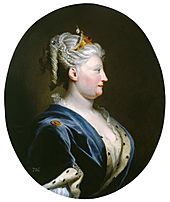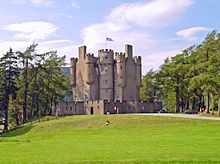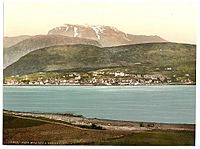Caroline Frederick Scott facts for kids
Quick facts for kids
Lt-Colonel Caroline Frederick Scott
|
|
|---|---|
| Born | c. 1711 Dresden |
| Died | 12 May 1754 (aged 42–43) Madras, now Chennai, Tamil Nadu |
| Allegiance | |
| Service/ |
|
| Years of service | 1737–1754 |
| Rank | Lieutenant-Colonel |
| Unit | 29th, later Worcestershire Regiment 1749–1752 |
| Commands held | Garrison commander, Fort William, March–August 1746 Engineer-General, East India Company 1752–1754 Major Commandant, Fort William, Calcutta |
| Battles/wars | |
| Relations | George Lewis Scott 1708–1780 (brother) James Stewart 1681–1727 (uncle) James Steuart 1707–1780 (cousin) |
Lieutenant-Colonel Caroline Frederick Scott (around 1711 – 12 May 1754) was a Scottish soldier and military engineer. He served in the British Army before joining the East India Company.
During the Jacobite Rising of 1745, he successfully defended Fort William in March 1746. Later, he was involved in the search for Prince Charles after the Battle of Culloden in April. He became known for his strict actions against Highlanders during this time.
In October 1752, he joined the East India Company. He became the Engineer General for their settlements in India, based in Calcutta. He sadly died from a fever in Madras (now Chennai) on 12 May 1754.
Contents
Early Life and Family

Caroline Frederick Scott was born in 1711. He was one of three sons of James (or George) Scott and Marion Stewart (1679–1727). His mother was the daughter of Sir James Stewart (1635–1715). Sir James was an important Scottish lawyer.
His father, James Scott, was from Edinburgh. He was a close friend of George I, who was then the Elector of Hanover. Between 1710 and 1724, James Scott held important diplomatic jobs in German courts. After her husband died in 1726, Marion moved to the Dutch Republic. This allowed her children to attend Leiden University.
Scott's unusual first name came from his godmother, Caroline of Ansbach (1683-1737). She was the wife of George II and mother of the Duke of Cumberland. Scott's family had interesting connections. His cousin, the economist James Steuart, was exiled for his part in the 1745 rebellion. His older brother, George (1708–1780), became a tutor to the future George III.
Scott never married but had four children with Martha Bowdler. They had three girls and a boy, who was also named Caroline Frederick (around 1752–1794). His son served in the Royal Artillery. He left the army in 1793 due to illness and died in Rochester in 1794.
Military Career
In 1737, Scott became an officer (a cornet) in the Royal North British Dragoons. This unit was based in England. In 1741, he moved to Guise's Regiment. During the War of Jenkins' Ear with Spain (1739-1748), Guise's Regiment was sent to the West Indies. They took part in an attack on Cartagena de Indias in May 1741. This expedition was very difficult, and many soldiers became sick. The survivors returned to England in December 1742.
Scott later served as a military engineer in Gibraltar. When the 1745 Rising began, he was in Flanders with the Duke of Cumberland. After the Battle of Prestonpans, Scott was among the troops sent to Scotland.
Defending Fort William
In February 1746, the Jacobites captured Fort Augustus. This left Fort William as the last government-controlled fort in the Great Glen. Cumberland made Scott the commander of Fort William, and he arrived there on March 15. The fort's defenses had been ignored, but it was strong and well-placed. It could also receive supplies by sea. The Jacobite commander, Colonel Stapleton, thought the fort was too strong to capture.
Scott's records show he defended the fort with great energy. The siege did not make much progress. At the end of March, Stapleton was ordered back to Inverness. On April 3, the defenders found that the Jacobites had left. Scott's defense was praised by the Duke of Newcastle.
After Culloden

After the Battle of Culloden on April 16, Scott led one of the groups searching for Prince Charles. On June 21, he landed at Kilbride, on Skye, just missing the Prince. During this search, he became known for his harsh actions. Many stories about him were collected later.
The actions taken after Culloden were common practice by both sides during the conflict. Many senior commanders, like James Wolfe and Henry Hawley, were involved in similar activities. One reason for this was the belief that another Jacobite landing was coming.
Scott clearly had a strong dislike for Highlanders and Jacobites. For example, in a letter of complaint, Isabel Haldane described how Scott's men damaged her property. Her husband, Charles Stewart of Ardshiel, had led a Jacobite regiment. Scott's men cut down her fruit trees, took her furniture, food, and livestock. They also took apart her house, and the materials were later sold.
Controlling the Highlands
In November 1746, Scott was promoted to major. He replaced Hugh Wentworth, who was removed for surrendering Fort Augustus. The Earl of Albemarle was put in charge of Scotland. He oversaw efforts to control the Highlands. After the Rising, the military road network was completed. Garrisons were placed at important points, like Inversnaid and Braemar Castle, which Scott commanded.
Soldiers regularly patrolled and enforced new laws. The Disarming Act allowed them to take away weapons. The Dress Act banned Highland dress unless worn for military service. Scott's reports show weapons found and arrests made for wearing Highland dress. He left this command at the end of October 1749.
Soon after, he joined the 29th Foot. By 1751, he was a Lieutenant-Colonel. He was based in Philipstown (now Daingean). Scott also wrote letters about army reform under the name 'Mr Lovetruth'.
Service in India

In October 1752, Scott joined the military service of the East India Company. He was appointed Engineer-General for all their settlements in India. He also became Major Commandant of Fort William, Calcutta. He arrived in Calcutta in September 1753. There, he started building new gunpowder mills. He also made detailed plans to improve Fort William's defenses.
He died of a fever on May 12, 1754, while visiting Madras (now Chennai). The construction work was still ongoing when Fort William was captured in 1756. Ensign Scott, who traveled with him from England and was likely a relative, was taken prisoner.
Images for kids
-
Scott was named after his godmother, Caroline of Ansbach (1683–1737). She was the mother of the Duke of Cumberland.
-
Fort William in Scotland, with Ben Nevis behind it (around 1890).
-
Braemar Castle was one of the strongholds built to control the Highlands. Scott commanded here until the end of 1749.
-
Fort William, Calcutta, around 1735. Scott made plans to improve it, but he died before they were finished.






